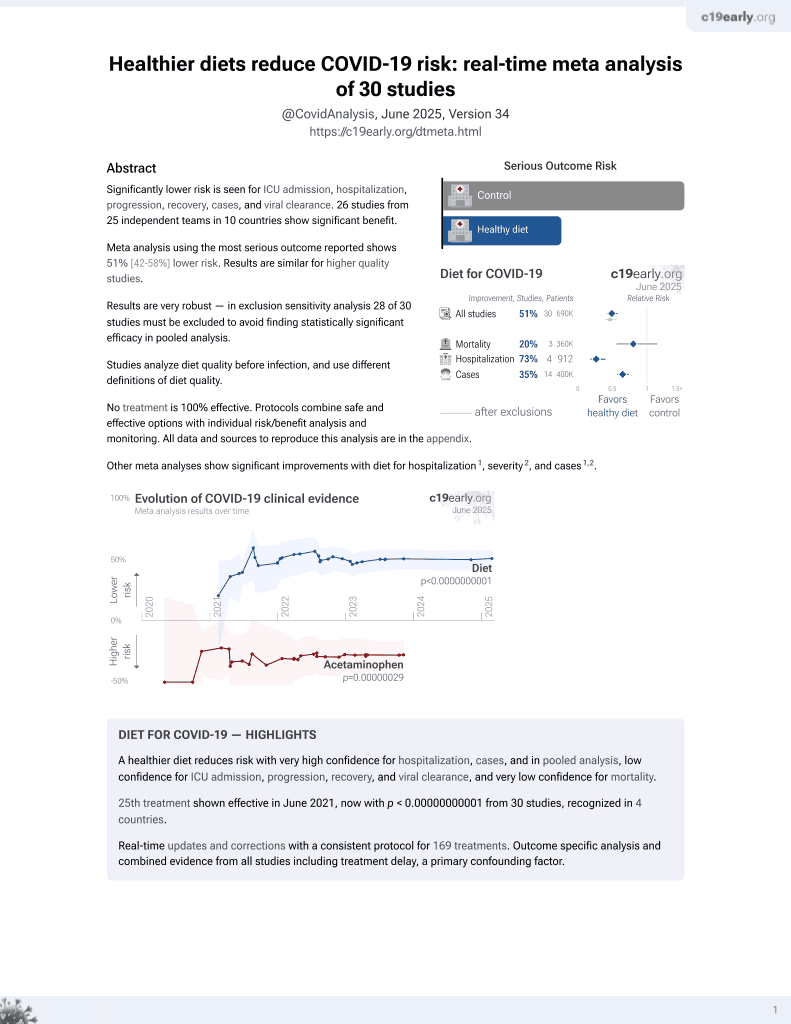
Cardiovascular risk factor insights into the Tesco 1.0 Dataset
et al., European Journal of Preventive Cardiology, doi:10.1093/eurjpc/zwac056.304, May 2022
Diet for COVID-19
26th treatment shown to reduce risk in
June 2021, now with p < 0.00000000001 from 30 studies, recognized in 4 countries.
No treatment is 100% effective. Protocols
combine treatments.
6,300+ studies for
210+ treatments. c19early.org
|
Tesco grocery purchase retrospective, showing COVID-19 mortality correlated with myocardial infarction mortality risk factors. Salt, percentage of fat and oils, and total weight increased risk, while fiber was protective.
Pimenta et al., 11 May 2022, United Kingdom, peer-reviewed, 2 authors.
1411 Cardiovascular risk factor insights into the Tesco 1.0 Dataset
Background: Tesco published an open-source dataset containing area-aggregated product purchase information from 420m transactions across 16m individual Clubcard users in the Great London area, at a borough level. This dataset is presented as a 'typical product' purchase for each borough, divided into 220 individual datapoints. Purpose: We wanted to explore dietary correlates with cardiovascular outcomes including age-standardised mortality rates for myocardial infarct, stroke, cardiac arrhythmia and COVID-19.
Methods: The Tesco 1.0 dataset was accessed on 1/11/21 and a sample of traditional dietary clinical risk and protective factor datapoints for each London borough were selected. Data for age-standardised mortality rates (ASMR) in each London borough were
DOI record:
{
"DOI": "10.1093/eurjpc/zwac056.304",
"ISSN": [
"2047-4873",
"2047-4881"
],
"URL": "http://dx.doi.org/10.1093/eurjpc/zwac056.304",
"abstract": "<jats:title>Abstract</jats:title>\n <jats:sec>\n <jats:title>Funding Acknowledgements</jats:title>\n <jats:p>Type of funding sources: None.</jats:p>\n </jats:sec>\n <jats:sec>\n <jats:title>Background</jats:title>\n <jats:p>Tesco published an open-source dataset containing area-aggregated product purchase information from 420m transactions across 16m individual Clubcard users in the Great London area, at a borough level. This dataset is presented as a ‘typical product’ purchase for each borough, divided into 220 individual datapoints.</jats:p>\n </jats:sec>\n <jats:sec>\n <jats:title>Purpose</jats:title>\n <jats:p>We wanted to explore dietary correlates with cardiovascular outcomes including age-standardised mortality rates for myocardial infarct, stroke, cardiac arrhythmia and COVID-19.</jats:p>\n </jats:sec>\n <jats:sec>\n <jats:title>Methods</jats:title>\n <jats:p>The Tesco 1.0 dataset was accessed on 1/11/21 and a sample of traditional dietary clinical risk and protective factor datapoints for each London borough were selected. Data for age-standardised mortality rates (ASMR) in each London borough were downloaded from the Office of National Statistics for 2019 for myocardial infarction, stroke, cardiac arrhythmia and 2020 COVID-19 deaths (March-July 2020). To explore for relevant associated factors, the average deprivation index (IMD) for each borough was accessed from Public Health England, and demographic data accessed from the Greater London Authority database.</jats:p>\n <jats:p>Statistics using Spearman’s Rho calculator were derived in Excel and calculated using a web-based statistics calculator.</jats:p>\n </jats:sec>\n <jats:sec>\n <jats:title>Results</jats:title>\n <jats:p>Myocardial infarction (MI) ASMR closely correlated with increased levels of salt (g), fat and oils (% of total product), and weight of purchase (g). Increased fibre (g) was correlated with lower MI mortality. An important associated risk factor was the deprivation index, a important co-variable to consider when assessing diet-health relationships.</jats:p>\n <jats:p>Stroke ASMR was more closely correlated with typical product constituents, significant risk factors were weight (g) of fat, carbohydrate, sugar and ready meals (%) and sweets (%), while % of fish and both % and total weight (g) of fruit and veg were protective factors. Importantly salt content was NOT a statistically significant factor.</jats:p>\n <jats:p>Cardiac arrhythmia ASMR did not correlate with any dietary constituents reviewed.</jats:p>\n <jats:p>COVID ASMR was closely correlated with myocardial infarction ASMR risk factors (salt, % of fat and oils and total weight of purchase) and total fibre (g) was again a protective factor. Interestingly, the % of ready meals was a protective factor for COVID ASMR, possibly associated with cultural and ethnicity-related behaviours, with higher BAME communities less likely to purchase ready meals.</jats:p>\n </jats:sec>\n <jats:sec>\n <jats:title>Conclusions</jats:title>\n <jats:p>This unique dataset offers a Big Data insight into the relationship between diet and health but is limited by a lack of individual granularity and heterogenous intra-borough populations. This research offers a starting point to further exploring in-depth food purchasing habits with healthcare outcomes, and further partnership in the future may unlock this.</jats:p>\n </jats:sec>",
"author": [
{
"affiliation": [
{
"name": "Richmond Research Institute, London, United Kingdom of Great Britain & Northern Ireland"
}
],
"family": "Pimenta",
"given": "D",
"sequence": "first"
},
{
"affiliation": [
{
"name": "Richmond Research Institute, London, United Kingdom of Great Britain & Northern Ireland"
}
],
"family": "Taubel",
"given": "J",
"sequence": "additional"
}
],
"container-title": "European Journal of Preventive Cardiology",
"content-domain": {
"crossmark-restriction": false,
"domain": []
},
"created": {
"date-parts": [
[
2022,
5,
11
]
],
"date-time": "2022-05-11T16:40:23Z",
"timestamp": 1652287223000
},
"deposited": {
"date-parts": [
[
2022,
5,
11
]
],
"date-time": "2022-05-11T16:40:24Z",
"timestamp": 1652287224000
},
"indexed": {
"date-parts": [
[
2022,
5,
11
]
],
"date-time": "2022-05-11T17:15:37Z",
"timestamp": 1652289337354
},
"is-referenced-by-count": 0,
"issue": "Supplement_1",
"issued": {
"date-parts": [
[
2022,
5,
1
]
]
},
"journal-issue": {
"issue": "Supplement_1",
"published-online": {
"date-parts": [
[
2022,
5,
11
]
]
},
"published-print": {
"date-parts": [
[
2022,
5,
11
]
]
}
},
"language": "en",
"license": [
{
"URL": "https://academic.oup.com/journals/pages/open_access/funder_policies/chorus/standard_publication_model",
"content-version": "vor",
"delay-in-days": 0,
"start": {
"date-parts": [
[
2022,
5,
1
]
],
"date-time": "2022-05-01T00:00:00Z",
"timestamp": 1651363200000
}
}
],
"link": [
{
"URL": "https://academic.oup.com/eurjpc/article-pdf/29/Supplement_1/zwac056.304/43671665/zwac056.304.pdf",
"content-type": "application/pdf",
"content-version": "vor",
"intended-application": "syndication"
},
{
"URL": "https://academic.oup.com/eurjpc/article-pdf/29/Supplement_1/zwac056.304/43671665/zwac056.304.pdf",
"content-type": "unspecified",
"content-version": "vor",
"intended-application": "similarity-checking"
}
],
"member": "286",
"original-title": [],
"prefix": "10.1093",
"published": {
"date-parts": [
[
2022,
5,
1
]
]
},
"published-online": {
"date-parts": [
[
2022,
5,
11
]
]
},
"published-other": {
"date-parts": [
[
2022,
5,
1
]
]
},
"published-print": {
"date-parts": [
[
2022,
5,
11
]
]
},
"publisher": "Oxford University Press (OUP)",
"reference-count": 0,
"references-count": 0,
"relation": {},
"resource": {
"primary": {
"URL": "https://academic.oup.com/eurjpc/article/doi/10.1093/eurjpc/zwac056.304/6583754"
}
},
"score": 1,
"short-title": [],
"source": "Crossref",
"subject": [
"Cardiology and Cardiovascular Medicine",
"Epidemiology"
],
"subtitle": [],
"title": "Cardiovascular risk factor insights into the Tesco 1.0 Dataset",
"type": "journal-article",
"volume": "29"
}
